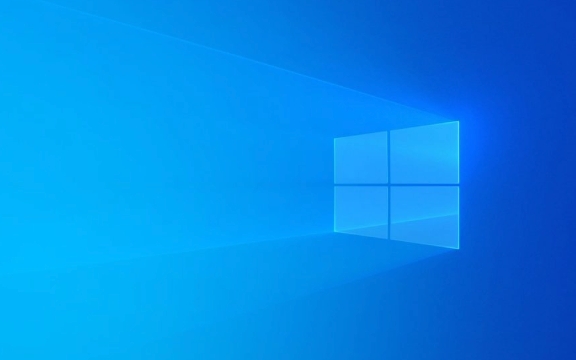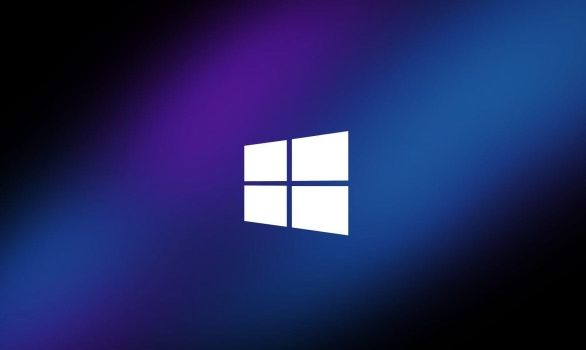How to manage environment variables for users in Windows
Aug 01, 2025 am 03:58 AMTo manage user environment variables in Windows, use the System Properties GUI by pressing Win R, typing sysdm.cpl, navigating to Environment Variables, and modifying user variables under "User variables for [your username]" to add, edit, or delete them, with changes applying to new processes. 2. In Command Prompt, view variables with set, set them permanently with setx VARIABLE_NAME "value", and clear them using setx VARIABLE_NAME "", noting that changes only affect new command prompt sessions. 3. In PowerShell, use Get-ChildItem Env: to view variables, [Environment]::SetEnvironmentVariable("VARIABLE_NAME", "value", "User") to set them, and [Environment]::SetEnvironmentVariable("VARIABLE_NAME", $null, "User") to remove them, ensuring the "User" scope for user-specific settings. 4. Best practices include avoiding manual PATH edits, restarting apps after changes, using standard variable names, not storing secrets unsecured, and backing up the HKEY_CURRENT_USER\Environment registry key before modifications. 5. For troubleshooting, open a new shell if variables aren’t recognized, use the GUI to fix PATH issues, ensure persistent methods like setx or GUI are used if changes don’t save, and remember that user variables apply to both admin and regular prompts. Managing user environment variables requires no admin rights and is safe when done carefully, with the GUI preferred for one-time changes, PowerShell for automation, and setx for quick command-line updates.

Managing environment variables for users in Windows is a common task for configuring software, scripting, or development workflows. These variables store values like paths, user preferences, or system settings that programs can access. Here’s how to manage user-specific environment variables in Windows effectively.

1. Using the System Properties GUI (Recommended for most users)
This is the easiest and safest way for most people.
Steps:
- Press
Win R, typesysdm.cpl, and press Enter.
(Alternatively: Right-click "This PC" > Properties > Advanced system settings) - In the System Properties window, go to the Advanced tab.
- Click the Environment Variables… button.
- Under "User variables for [your username]", you’ll see variables that apply only to your user account.
To add, edit, or delete:
- Add: Click New, enter the variable name and value.
- Edit: Select a variable and click Edit.
- Delete: Select and click Delete (be cautious—some apps may rely on them).
? Changes apply to new processes. You may need to restart apps (or reboot) for some programs to recognize the changes.

2. Using Command Prompt (cmd)
You can view or temporarily set user environment variables using set and setx.
View current user variables:
set
This shows all variables (system user). To filter:

set USERNAME set PATH
Set a user environment variable permanently:
setx VARIABLE_NAME "value"
Example:
setx JAVA_HOME "C:\Program Files\Java\jdk-17"
??
setxwrites to the registry and persists across reboots. But note: it only affects new command prompts—existing ones won’t see the change.
Remove a variable:
There’s no direct setx delete, but you can clear it:
setx VARIABLE_NAME ""
Or delete it via the GUI or PowerShell.
3. Using PowerShell (More powerful and scriptable)
PowerShell gives you better control, especially for automation.
View user environment variables:
Get-ChildItem Env:\ | Where-Object { $_.Name -notin (Get-ChildItem 'HKLM:\System\CurrentControlSet\Control\Session Manager\Environment') | ForEach-Object { $_.Name } }Or simply list all and manually identify user ones:
Get-ChildItem Env:
Set a user environment variable:
[Environment]::SetEnvironmentVariable("VARIABLE_NAME", "value", "User")Example:
[Environment]::SetEnvironmentVariable("NODE_ENV", "development", "User")Remove a user variable:
[Environment]::SetEnvironmentVariable("VARIABLE_NAME", $null, "User")? The
"User"scope ensures it’s saved for the current user only. Use"Machine"for system-wide (requires admin).
4. Best Practices and Tips
- Avoid modifying PATH manually in text editors – the GUI or
setxhandles it better and reduces syntax errors. - Restart your shell or apps after changes—old terminals won’t see updated variables.
- Use clear, standard names like
JAVA_HOME,PYTHONPATH,WORKSPACE, etc. - Don’t store secrets (passwords, API keys) in environment variables unless the system is secure.
- Back up before bulk changes – user variables are stored in the registry under:
HKEY_CURRENT_USER\Environment
5. Troubleshooting Common Issues
Variable not recognized?
→ Open a new Command Prompt or PowerShell window.PATH too long or corrupted?
→ Edit it in the GUI to avoid syntax errors (missing semicolons, etc.).Changes not saving?
→ Make sure you’re not setting them in a temporary session. Usesetxor the GUI for permanence.Different behavior in admin vs. regular prompt?
→ Admin processes inherit system variables, but user variables should still apply.
Managing user environment variables in Windows doesn’t require admin rights and is safe when done carefully. Whether you prefer GUI, command line, or automation, the key is knowing where they’re stored and how scope affects visibility.
Basically, use the GUI for one-offs, PowerShell for scripts, and
setxfor quick CLI changes.The above is the detailed content of How to manage environment variables for users in Windows. For more information, please follow other related articles on the PHP Chinese website!

Hot AI Tools

Undress AI Tool
Undress images for free

Undresser.AI Undress
AI-powered app for creating realistic nude photos

AI Clothes Remover
Online AI tool for removing clothes from photos.

Clothoff.io
AI clothes remover

Video Face Swap
Swap faces in any video effortlessly with our completely free AI face swap tool!

Hot Article

Hot Tools

Notepad++7.3.1
Easy-to-use and free code editor

SublimeText3 Chinese version
Chinese version, very easy to use

Zend Studio 13.0.1
Powerful PHP integrated development environment

Dreamweaver CS6
Visual web development tools

SublimeText3 Mac version
God-level code editing software (SublimeText3)
 How to change the system display language for all users in Windows
Jul 31, 2025 am 08:18 AM
How to change the system display language for all users in Windows
Jul 31, 2025 am 08:18 AM
InstallthedesiredlanguagepackviaSettings→Time&Language→Language®ion,ensuring"SetasmyWindowsdisplaylanguage"isselected.2.Changethesystemdisplaylanguageinthesamemenuandrestart.3.OpenControlPanel→Region→Administrativetab,click"
 How to reset the Microsoft Store in Windows
Jul 31, 2025 am 08:23 AM
How to reset the Microsoft Store in Windows
Jul 31, 2025 am 08:23 AM
ResettheMicrosoftStoreviaSettingsbygoingtoApps>Installedapps,selectingMicrosoftStore,clickingAdvancedoptions,thenRepairandResetifneeded.2.Ifthatfails,re-registertheStoreusingPowerShellasadminwiththecommand:Get-AppXPackage-NameMicrosoft.WindowsStor
 How to install Windows on a Mac without Boot Camp
Jul 31, 2025 am 11:58 AM
How to install Windows on a Mac without Boot Camp
Jul 31, 2025 am 11:58 AM
Without BootCamp, installing Windows on Mac is feasible and works for different chips and needs. 1. First check compatibility: The M1/M2 chip Mac cannot use BootCamp, it is recommended to use virtualization tools; the Intel chip Mac can manually create a boot USB disk and install it in partition. 2. Recommended to use virtual machines (VMs) for M1 and above chip users: Windows ISO files, virtualization software (such as ParallelsDesktop or UTM), at least 64GB of free space, and reasonably allocate resources. 3. IntelMac users can manually install it by booting the USB drive: USB drive, WindowsISO, DiskU is required
 How to reset the TCP/IP stack in Windows
Aug 02, 2025 pm 01:25 PM
How to reset the TCP/IP stack in Windows
Aug 02, 2025 pm 01:25 PM
ToresolvenetworkconnectivityissuesinWindows,resettheTCP/IPstackbyfirstopeningCommandPromptasAdministrator,thenrunningthecommandnetshintipreset,andfinallyrestartingyourcomputertoapplychanges;ifissuespersist,optionallyrunnetshwinsockresetandrebootagain
 How to install Windows on a Mac
Jul 31, 2025 am 10:07 AM
How to install Windows on a Mac
Jul 31, 2025 am 10:07 AM
ForIntel-basedMacs,useBootCampAssistanttocreateadual-bootsystemwithWindowsbypreparingaUSBdrive,downloadingaWindowsISO,partitioningthedisk,andinstallingWindowsalongsidemacOSwithsupportdrivers.2.ForAppleSiliconMacs(M1/M2/M3),usevirtualizationsoftwareli
 Step-by-step guide to installing Windows from an ISO file
Aug 01, 2025 am 01:10 AM
Step-by-step guide to installing Windows from an ISO file
Aug 01, 2025 am 01:10 AM
DownloadtheWindowsISOfromMicrosoft’sofficialsite.2.CreateabootableUSBusingMediaCreationToolorRufuswithaUSBdriveofatleast8GB.3.BootfromtheUSBbyaccessingthebootmenuoradjustingBIOS/UEFIsettings.4.InstallWindowsbyselectingcustominstallation,choosingtheco
 A guide to custom Windows installation options
Aug 01, 2025 am 04:48 AM
A guide to custom Windows installation options
Aug 01, 2025 am 04:48 AM
Choose"Custom:InstallWindowsonly(advanced)"forfullcontrol,asitallowsacleaninstallthatremovesoldissuesandoptimizesperformance.2.Duringsetup,managepartitionsbydeletingoldones(afterbackingupdata),creatingnewpartitions,formatting(usingNTFS),ors
 How to manage AppLocker policies in Windows
Aug 02, 2025 am 12:13 AM
How to manage AppLocker policies in Windows
Aug 02, 2025 am 12:13 AM
EnableAppLockerviaGroupPolicybyopeninggpedit.msc,navigatingtoApplicationControlPolicies,creatingdefaultrules,andconfiguringruletypes;2.Createcustomrulesusingpublisher,path,orhashconditions,preferringpublisherrulesforsecurityandflexibility;3.Testrules







